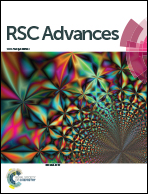A porous nanobranched structure: an effective way to improve piezoelectricity in sputtered ZnO thin films†
Abstract
ZnO nanomaterials are gaining lots of attention due to their biocompatible nature coupled with promising piezoelectric properties, envisioning a new generation of lead-free smart materials. Herein, an effective strategy to improve the piezoelectric behaviour of sputtered ZnO thin films is proposed by introducing a nanobranched porous thin film structure composed by a network of randomly-oriented wurtzite crystallites, rather than using compact ZnO thin films, considered in this work as a conventional reference for sputtered ZnO thin film structures. The nanobranched ZnO structure shows a hydrophilic behavior together with a piezoelectric output voltage of around 3 V. In comparison, compact ZnO thin films exhibit a maximum piezoelectric voltage generation below 0.8 V and a hydrophobic state. The more defective structure of the nanobranched ZnO thin films, with respect of the long-range ordered crystal structure of compact ZnO thin films, reduces free carrier concentration and mobility, thus limiting the screening potential and at the same time improving piezoelectric voltage generation. All the characterization results highlight the promising perspectives in using nanobranched ZnO thin films as novel piezoelectric materials for biosensing and tissue engineering applications, as well as for lead-free piezoelectric sensors and energy harvesting systems.


 Please wait while we load your content...
Please wait while we load your content...